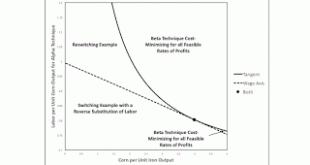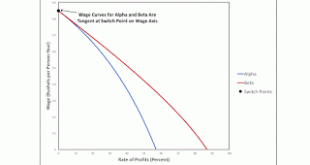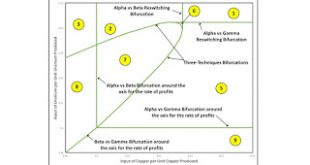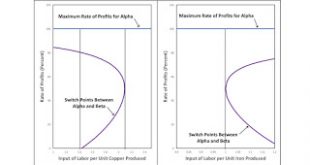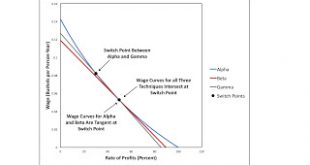Read More »
Bifurcation Diagram for Fluke Switch Point
Figure 1: A Bifurcation Diagram I have previously illustrated a case in which real Wicksell effects are zero. I wrote this post to present an argument that that example is not a matter of round-off error confusing me. Consider the technology illustrated in Table 1. The managers of firms know of three processes of production. These processes exhibit Constant Returns to Scale. The column for the iron industry specifies the inputs needed to produce a ton of iron. Two processes are known for...
Read More »Fluke Switch Points and a Real Wicksell Effect of Zero
I have put up a draft paper with the post title on my SSRN site. Abstract: This note presents two numerical examples, in a model with two techniques of production, of a switch point with a real Wicksell effect of zero. The variation in the technique adopted, at the switch point, leaves employment and the value of capital per unit net output unchanged. This invariant generalizes to switch points with a real Wicksell effect of zero for steady states with a positive rate of growth.
Read More »A Fluke Switch Point With A Real Wicksell Effect Of Zero
Figure 1: A Fluke Switch Point1.0 Introduction A switch point in which the wage curves for two techniques are tangent to one another at the switch point is a fluke. Likewise, a switch point that occurs at a rate of profits of zero is a fluke. This post presents a two-commodity example with a choice between two techniques, in which the single switch point is simultaneously both types of flukes. The wage curves are tangent at the switch point, and the switch point occurs at a rate of...
Read More »Example With Four Normal Forms For Bifurcations Of Switch Points
Figure 1: A Blowup of a Bifurcation Diagram1.0 Introduction I have been working on an analysis of structural economic dynamics with a choice of technique. Technical progress can result in a variation in the switch points and the succession of techniques with wage curves on the outer wage frontier. I call such a variation a bifurcation, and I have identified normal forms for four generic bifurcations. This post prevents an example in which all four generic bifurcations appear. 2.0...
Read More »The Concept Of Totality
This post is inspired by current events "It is not the primacy of economic motives in historical explanation that constitutes the decisive difference between Marxism and bourgeois thought, but the point of view of totality. The category of totality, the all-pervasive supremacy of the whole over the parts is the essence of the method which Marx took over from Hegel and brilliantly transformed into the foundations of a wholly new science. The capitalist separation of the producer from the...
Read More »A Reswitching Bifurcation, Reflected
Figure 1: Two Bifurcation Diagrams Horizontally Reflecting1.0 Introduction This post continues my investigation of structural economic dynamics. I am interested in how technological progress can change the analysis of the choice of technique. I have four normal forms for how switch points can appear on or disappear from the wage frontier, as a result of changes in coefficients of production. This post concentrates on what I call a reswitching bifurcation. Each bifurcation can be...
Read More »Elsewhere
Nick Hanauer argues for some policies that postulate: Income distribution is not a matter of supply and demand or any other sort of economic natural laws. That a more egalitarian distribution of income leads to an increased demand and generalized shared prosperity. Tom Palley contrasts neoliberalism with an economic theory with an approach with another "theory of income distribution and its theory of aggregate employment determination". Elizabeth Bruenig contrasts liberalism with the the...
Read More »A Fluke Of A Fluke Switch Point
Figure 1: Wage Curves1.0 Introduction This post presents an example of the analysis of the choice of technique in competitive markets. The example is one with three techniques and two switch points. The wage curves for the Alpha and Beta techniques are tangent at one of the switch points. This is a fluke. And the wage curves for all three techniques all pass through that same switch point. This, too, is a fluke. I suppose that the example is one of reswitching and capital-reversing is...
Read More »Some Unresolved Issues In Multiple Interest Rate Analysis
1.0 Introduction Come October, as I understand it, the Review of Political Economy will publish, in hardcopy, my article The Choice of Technique with Multiple and Complex Interest Rates. I discuss in this post questions I do not understand. 2.0 Non-Standard Investments and Fixed Capital Consider a point-input, flow-output model. In the first year, unassisted labor produces a long-lived machine. In successive years, labor and a machine of a specific history are used to produce outputs of a...
Read More » Robert Vienneau: Thoughts Economics
Robert Vienneau: Thoughts Economics

